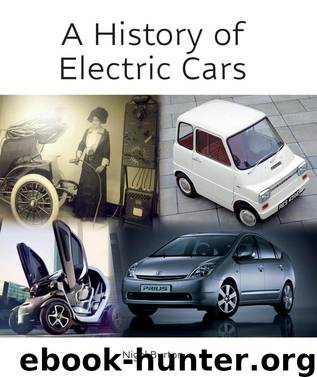History of Electric Cars by Nigel Burton

Author:Nigel Burton [Nigel Burton]
Language: eng
Format: epub
ISBN: 9781847975713
Publisher: Crowood
Published: 2013-04-23T16:00:00+00:00
The ETX-1 advanced electric powertrain programme was officially completed in August 1985. Tests performed under the programme verified that the vehicle met its targets for energy consumption, acceleration and what the DOE called ‘automotive-industry-acceptable driveability’, although, as it was an offspring of the fairly unremarkable Escort, no one was hailing the EXT-1 as a great driver’s car.
Encouraged by this success, the DOE had already placed a second contract in March 1985 for a second-generation, single-shaft, electric-propulsion system. However, the US Government had given up on the idea of convincing North Americans to forsake their gas-guzzlers in favour of EVs. The ETX-II project was for a small commercial van application. This was a shame as, by July 1988, Ford and GE had developed the AC drive system used in the ETX-1 into a very advanced powertrain indeed, using new UK-designed sodium-sulphur batteries.
The advanced AC electric drive system used a 70bhp motor, courtesy of GE Motors, that was claimed to be 96 per cent efficient. The maximum torque output was 81lb ft (110Nm), which made it perfect for commercial applications. Fitted to a Ford Aerostar minivan, the ETX-II had a range of 100 miles (160km) and a top speed of 60mph (96km/h).
Unlike the ETX-1 powertrain, which was designed to replace a front-wheel drive set up, the ETX-II was designed for rear-wheel drive applications. The major powertrain differences were:
The ETX-II incorporated an AC interior permanent magnet traction motor, as compared to the AC induction motor used in the ETX-I.
The motor/transaxle was arranged as a rigid rear-wheel drive axle, eliminating the need for the constant velocity joints that were needed for front-wheel drive.
The ETX-II powerplant was also designed for much heavier applications, where higher power and torque were required.
The ETX-II incorporated new gear ratios to satisfy the requirements for performance and energy efficiency.
Download
This site does not store any files on its server. We only index and link to content provided by other sites. Please contact the content providers to delete copyright contents if any and email us, we'll remove relevant links or contents immediately.
| Buyers' Guides | Classic Cars |
| Customize | Driver's Education |
| Electric & Hybrid | Foreign |
| History | Industry |
| Insurance | Luxury |
| Motorcycles | Pictorial |
| Racing | Repair & Maintenance |
| Trucks & Vans |
Machine Learning at Scale with H2O by Gregory Keys | David Whiting(4179)
Never by Ken Follett(3790)
Urban Outlaw by Magnus Walker(3340)
OPNsense Beginner to Professional by Julio Cesar Bueno de Camargo(3251)
Sapiens and Homo Deus by Yuval Noah Harari(2987)
Will by Will Smith(2792)
A Short History of Nearly Everything by Bryson Bill(2629)
Hooked: A Dark, Contemporary Romance (Never After Series) by Emily McIntire(2500)
Rationality by Steven Pinker(2291)
Borders by unknow(2227)
The Becoming by Nora Roberts(2087)
Holy Bible (NIV) by Zondervan(2086)
The One Percenter Encyclopedia by Bill Hayes(1787)
HBR's 10 Must Reads 2022 by Harvard Business Review(1776)
Freedom by Sonny Barger(1771)
A Short History of War by Jeremy Black(1762)
Five Ways to Fall by K.A. Tucker(1700)
Go Tell the Bees That I Am Gone by Diana Gabaldon(1687)
Girls Auto Clinic Glove Box Guide by Patrice Banks(1684)
